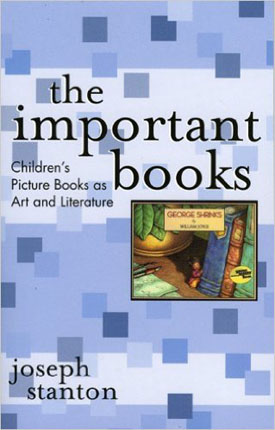 I am more than a little pleased to learn that I am not the only person who would think of comparing a children’s picture book with Les Tres Rich Heures du Duc de Berry, which is exactly what Joseph Stanton does in his essay on The Ox-Cart Man by Donald Hall and Barbara Cooney. This is only one of the thoughtful and illuminating studies in The Important Books. (And please do pardon the pun.)
I am more than a little pleased to learn that I am not the only person who would think of comparing a children’s picture book with Les Tres Rich Heures du Duc de Berry, which is exactly what Joseph Stanton does in his essay on The Ox-Cart Man by Donald Hall and Barbara Cooney. This is only one of the thoughtful and illuminating studies in The Important Books. (And please do pardon the pun.)
The relationship between word and image is one that has intrigued people for centuries, from the Limbourg Brothers through Albrecht Dürer to Foote, Cone and Belding. (That last reference is not meant as a joke: the methods of advertising have indeed swept into high art in the past fifty years, starting with Andy Warhol, and of course, the use of images to reinforce words is key to modern advertising.) The use of illustrations in children’s literature, especially, seems self-evident, but like all such endeavors, there is probably more going on than is apparent at first glance.
In “The Cycle of the Seasons in Hall and Cooney’s Ox-Cart Man,” Stanton does indeed compare the book to the Limbourg Brothers’ masterwork: Ox-Cart Man is an illustrated catalogue of the products that the man and his family have grown and made in the course of the year being taken to market, in the same way that the Tres Riches Heures shows the Duke’s tenants at their seasonal tasks. The implication is the same: as Stanton points out, we identify with the protagonists and “ride the cycle of the book’s seasons and enjoy a taste of a circular eternity.” He also discusses Donald Hall’s work as a poet and Barbara Cooney’s later career as an illustrator and author of children’s books.
His treatment of Maurice Sendak’s New York picture books is somewhat different, although just as insightful. Focusing on In the Night Kitchen and We Are All in the Dumps with Jack and Guy, Stanton studies the tension in Sendak’s use of the contrast between the mundane and the phantasmagoric, exemplified by the Brooklyn of Sendak’s childhood and Manhattan. Among other tidbits, Stanton points out the use in Night Kitchen of the iconic image of the evil witch who puts children into an oven, as exemplified by the fairy tale “Hansel and Gretel.”
One thing that is striking about children’s literature is its reliance on children’s acceptance of the surreal as a characteristic of life. To children, with their limited experience, life is pretty much unexplainable in rational terms anyway (particularly when adults can’t come up with an answer to the eternal question: “Why?”), and so the irrational is matter-of-factly incorporated into their world view. Thus it is no surprise that author/illustrators such as Chris Van Allsburg make blatant use of the surreal as a basis for their work. Stanton makes an intriguing link between the high art concept of surrealism as practiced by the second generation surrealists such as Giorgio de Chirico, Max Ernst, and Rene Magritte and the popular culture tradition of the “strangely-enough tale,” so prevalent in early pulp fiction and comics. The two fuse in Van Allsburg’s work with fascinating results.
There are equally interesting essays on Margaret Wise Brown, Arnold Lobel, and William Joyce, all of which serve to bring children’s picture books into a greater context as both literature and art. Although a slim volume, only 88 pages, Stanton’s collection of essays is solidly reasoned and cogently argued. I also found it a good explanation as to why children’s picture books hold so much fascination for adults.
(Scarecrow Press, 2005)
